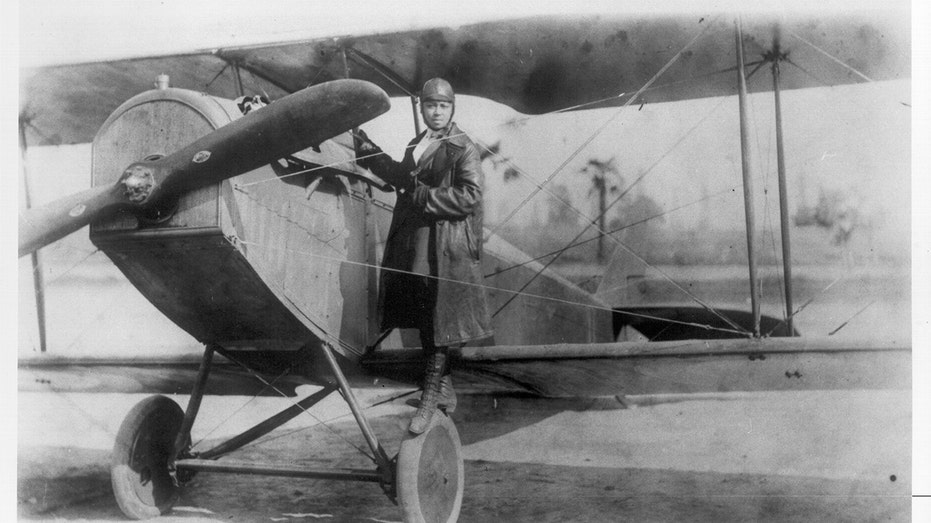Bessie Coleman was the first African American woman to earn a pilot’s license.
Coleman, who earned nicknames such as “Brave Bessie” and “Queen Bessie,” spent her life teaching others about aviation, performing in flight shows and encouraging others, especially African Americans and women, to pursue their dreams.
Coleman’s life was tragically cut short in a flying accident on April 30, 1926, but her legacy continues to live on today.
A NEW TYPE OF PILOT COULD BE THE KEY TO SOLVING A LOOMING CRISIS IN THE SKIES
Read on about Coleman and how she worked her way to earning her pilot’s license.
Coleman was the first woman of African American and Native American descent to earn her pilot’s license, according to the U.S. National Women’s History Museum.
She became interested in flying planes after her brothers served in the military during World War I. When they came home, they shared stories of women in France who were able to learn how to fly planes, according to the source.
This inspired Coleman to seek her pilot’s license, but she achieved no success in the United States, getting rejected from schools throughout the country.
Under the advice of Robert Abbott, who founded the Chicago Defender newspaper, she sought out training in France, according to the National Air and Space Museum.
AIRPLANE PILOT LEAVES COCKPIT TO HELP DELIVER BABY DURING FLIGHT TO THAILAND: ‘BORN IN THE AIR’
She gained admission to Caudron Brothers’ School of Aviation in Le Crotoy, France, and earned her international pilot’s license on June 15, 1921, from Fédération Aéronautique Internationale, according to the U.S. National Women’s History Museum.
After receiving her license, she returned to the United States, where she gave flight lessons and also performed flight shows. She was famous for doing tricks like “loop the loops” and figure eights in the sky.
Coleman was born in Atlanta, Texas, on Jan. 26, 1892. She grew up in a large family with 12 brothers and sisters.
When she was young, George Coleman, her father, moved back to Oklahoma in hopes of escaping the discrimination in Texas, according to the U.S. National Women’s History Museum.
Her mother, Susan Coleman, and the children stayed behind.
In her early life, before pursuing her pilot’s license, Coleman helped her mother pick cotton and wash laundry for extra money, according to the U.S. National Women’s History Museum.
Throughout her life, Coleman refused to perform in any place that segregated or discriminated against African Americans, according to the U.S. Mint, making her a strong advocate for equal rights.
CIVIL RIGHTS LEADERS, SCHOLARS, DESCENDANTS OF SLAVES SPEAK OUT ON REPARATIONS FOR BLACK AMERICANS
After receiving her pilot’s license, she toured the country giving flight lessons and encouraging African Americans and women to learn how to fly.
On Sept. 3, 1922, she performed in the first public flight by an African American woman in the United States, according to Britannica.
Throughout her flying career, Coleman saved enough money that she was able to purchase her own plane, a Jenny – JN-4 with an OX-5 engine, according to the U.S. National History Museum.
When she returned to the segregated state of Texas, her home state, to perform, the managers of the event planned to include two separate entrances.
Coleman refused to perform under those conditions, and after deliberation, management decided to oblige and had just one gate at the event, although the sections of the stadium remained segregated, the source reported.
On April 30, 1936, Coleman was on a test flight with a mechanic named William Wills, who was flying the plane. Coleman sat as the passenger.
Due to a loose wrench becoming stuck in the engine, the plane flipped while in the air, causing Coleman, who was not wearing a seat belt, to fall out of the plane, which had an open roof, according to the U.S. Women’s History Museum.
Wills died when the plane crashed, according to the source.
Coleman was 34 years old when she died.
Today, Coleman’s impact and legacy live on.
There have been many aviation clubs named after her, such as the Bessie Coleman Aero Club, which began in the 1930s, and Bessie Coleman Aviators, which began in Chicago in the 1970s, according to the U.S. Women’s History Museum.
Also in her honor, beginning in 1931, the Challenger Pilots’ Association flies over her grave annually, according to the source.
In 2023, there was a special quarter featuring the pilot by the U.S. Mint. This quarter was released as part of their American Women Quarters Program. This program started in 2022, and has plans to run through 2025. It was designed to celebrate “the accomplishments and contributions made by women of the United States,” according to the U.S. Mint.
























